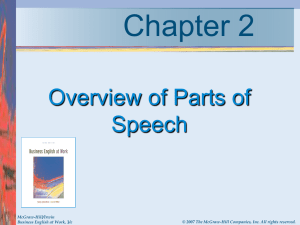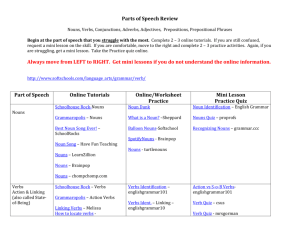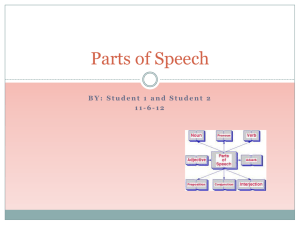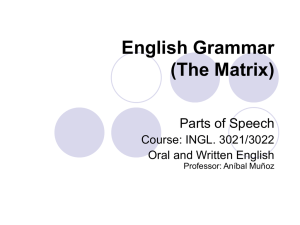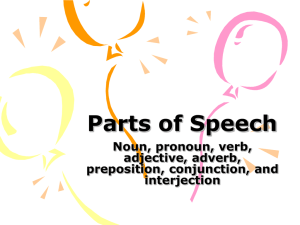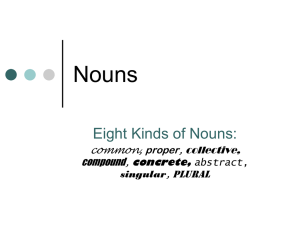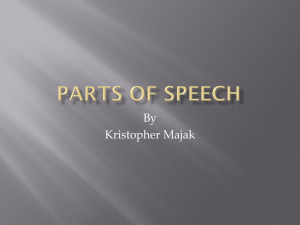Business Communication - Tipton County Schools, TN
advertisement
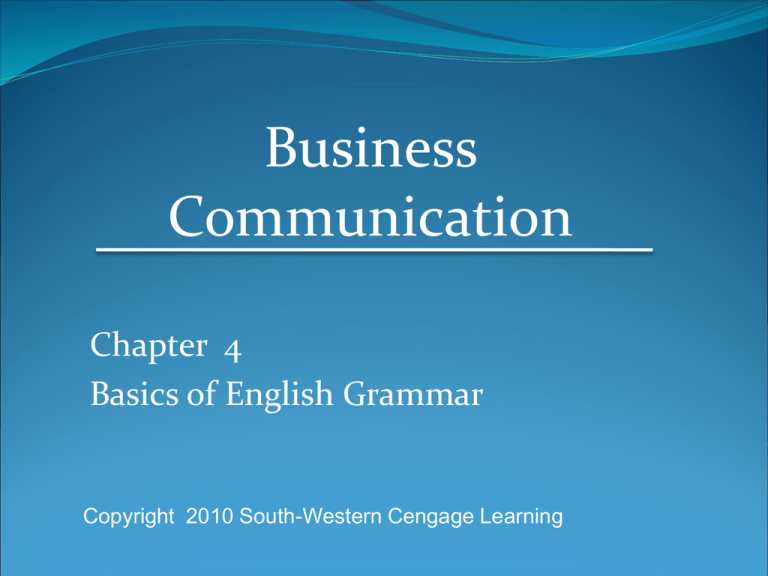
Business Communication Chapter 4 Basics of English Grammar Copyright 2010 South-Western Cengage Learning TN State Objectives: 8) Evaluate, create, and revise business correspondence, short contracts and reports, electronic forms, and small legal documents for a business in standard English using the following: b). Using proper grammar essentials, including parts of speech, vocabulary, punctuation, sentence structure. 2 Parts of Speech Noun – names a person, place or thing. ex: Pronoun – takes the place of a noun. ex: Adjective – describes a noun or pronoun. ex: Verb – a word or phrase that describes the action, state of being, or condition of a person, place or thing. ex: 4.1 Parts of Speech and Sentences 3 Parts of Speech Adverb – describes a verb, adjective, or another adverb. ex: Preposition – connects a noun or pronoun to other words to form a phrase. ex: Conjunction – joins words or phrases, or clauses. ex: Interjection – expresses surprise or strong feeling. ex: 4.1 Parts of Speech and Sentences 4 Parts of Speech Activity “Using well-structured sentences will help you communicate clearly” 5 Sentence Parts Subject © Image Source / Getty Images is the person who is speaking, the person who is spoken to, or the person, place or thing about whom is spoken. A simple subject is the main word in the complete subject that identifies specifically who or what the sentence concerns. The simple subject of a sentence is never in a prepositional phrase. A complete subject includes the simple subject plus all the sentence that is not part of the complete subject Examples: John writes articles for a newspaper. John, the young journalist, has written articles for a newspaper. A compound subject is two or more simple subjects joined by conjunctions. Ex: John and Hallie work for our company. 4.1 Parts of Speech and Sentences 6 Sentence Parts Predicate © Image Source / Getty Images The complete predicate is everything in the sentence said by, to, or about the subject. It includes the main verb of the sentence. Whatever is not included in the complete subject of a sentence belongs in the complete predicate. The simple predicate is the verb in the complete predicate. Examples: John writes articles for the newspaper. John, the young journalist, has written articles for the newspaper. A compound predicate consists of two or more verbs with the same subject. Ex: John and Hallie discussed the matter and concluded that we are handling this situation incorrectly. 4.1 Parts of Speech and Sentences 7 Creating Sentences Activity “Using well-structured sentences will help you communicate clearly” 8 QUIZ 9 Sentence Parts Objects and subject complements Direct objects Indirect objects Subject complements © Image Source / Getty Images Using well-structured sentences will help you communicate clearly. 4.1 Parts of Speech and Sentences 10 Clauses, Phrases, and Fragments Clause: a group of words with a subject and a predicate Phrase: a group of related words with no subject or predicate Fragment: an incomplete sentence that may or may not have meaning 4.1 Parts of Speech and Sentences 11 Sentence Structure Simple sentences Example: Theodore sings and acts. Compound sentences Example: Erin loves to ride horses; Manuel loves to draw horses. Complex sentences Example: Although it is important to proofread a written message, many people feel they do not have the time. 4.1 Parts of Speech and Sentences 12 Nouns Noun: a word used to name people, places, or things Common nouns Proper nouns Singular and plural nouns Collective nouns Possessive nouns 4.2 Nouns, Pronouns, and Adjectives 13 Pronouns Pronoun: a word used in the place of a noun Personal pronouns Nominative case Objective case Possessive case Intensive and reflective pronouns Interrogative and demonstrative pronouns 4.2 Nouns, Pronouns, and Adjectives 14 Pronoun-Antecedent Agreement Pronoun antecedent: a noun or phrase that is replaced by a pronoun Pronouns and antecedents should agree in: Person Number Gender Compound antecedents Indefinite pronoun agreement 4.2 Nouns, Pronouns, and Adjectives 15 Adjectives Adjective: a word that describes or limits nouns and pronouns Articles Nouns and pronouns used as adjectives Compound adjectives 4.2 Nouns, Pronouns, and Adjectives 16 Adjectives Comparison of adjectives Positive degree Comparative degree Superlative degree Absolute adjectives 4.2 Nouns, Pronouns, and Adjectives 17 Verbs Verb: a word that expresses action, a state of being, or a condition Types of verbs Action verbs Linking verbs State of being verbs 4.3 Verbs and Adverbs 18 Verbs Tenses Simple tenses Present Past Future Perfect tenses Present perfect Past perfect Future perfect 4.3 Verbs and Adverbs 19 Verbs Transitive verbs Intransitive verbs Voice Active voice Passive voice 4.3 Verbs and Adverbs 20 Subject and Verb Agreement Number Intervening phrases “A number,” “the number” Names of companies Amounts Compound subjects 4.3 Verbs and Adverbs 21 Adverbs Adverb: a word that modifies an action verb, an adjective, or another adverb Conjunctive adverbs Comparison of adverbs Positive degree Comparative degree Superlative degree 4.3 Verbs and Adverbs 22 Prepositions Preposition: a word that connects a noun or pronoun to other words to form a phrase Prepositions introduce phrases Prepositional phrases may modify: Nouns (acting as adjectives) Action verbs Adjectives Adverbs 4.4 Prepositions, Conjunctions, and Interjections 23 Conjunctions Conjunction: a word or phrase that joins two or more words, phrases, or clauses Coordinate conjunctions Correlative conjunctions Subordinate conjunctions Parallel construction 4.4 Prepositions, Conjunctions, and Interjections 24 Interjections Interjection: a word or phrase used primarily to express strong emotion Have no grammatical relationship with other words in the sentence 4.4 Prepositions, Conjunctions, and Interjections 25 Vocabulary active voice adjective adverb clause collective noun conjunction direct object fragment indirect object interjection noun passive voice phrase possessive noun predicate preposition pronoun pronoun antecedent sentence subject verb verb tense 26
